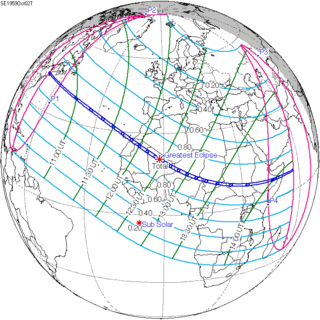| Solar eclipse of October 2, 1959 | |
|---|---|
| Type of eclipse | |
| Nature | Total |
| Gamma | 0.4207 |
| Magnitude | 1.0325 |
| Maximum eclipse | |
| Duration | 182 s (3 min 2 s) |
| Coordinates | 20°24′N 1°24′W / 20.4°N 1.4°W |
| Max. width of band | 120 km (75 mi) |
| Times (UTC) | |
| Greatest eclipse | 12:27:00 |
| References | |
| Saros | 143 (20 of 72) |
| Catalog # (SE5000) | 9419 |
A total solar eclipse occurred at the Moon's ascending node of orbit on Friday, October 2, 1959,[1] with a magnitude of 1.0325. A solar eclipse occurs when the Moon passes between Earth and the Sun, thereby totally or partly obscuring the image of the Sun for a viewer on Earth. A total solar eclipse occurs when the Moon's apparent diameter is larger than the Sun's, blocking all direct sunlight, turning day into darkness. Totality occurs in a narrow path across Earth's surface, with the partial solar eclipse visible over a surrounding region thousands of kilometres wide. Occurring about 2.4 days before perigee (on October 4, 1959, at 21:10 UTC), the Moon's apparent diameter was larger.[2]
Totality was visible from northeastern Massachusetts and the southern tip of New Hampshire in the United States, the Canary Islands, Morocco, Spanish Sahara (today's West Sahara) including the capital city Laayoune, French Mauritania (today's Mauritania), Mali Federation (part now belonging to Mali), French Niger (today's Niger), British Nigeria (today's Nigeria), British Cameroons and French Cameroons (now belonging to Cameroon), French Chad (today's Chad) including the capital city Fort-Lamy, French Central Africa (today's Central African Republic), Sudan (part of the path of totality is now in South Sudan), Ethiopia, and the Trust Territory of Somaliland (today's Somalia). A partial eclipse was visible for parts of eastern North America, the eastern Caribbean, Europe, Africa, West Asia, and Central Asia.
- ^ "October 2, 1959 Total Solar Eclipse". timeanddate. Retrieved 6 August 2024.
- ^ "Moon Distances for London, United Kingdom, England". timeanddate. Retrieved 6 August 2024.
